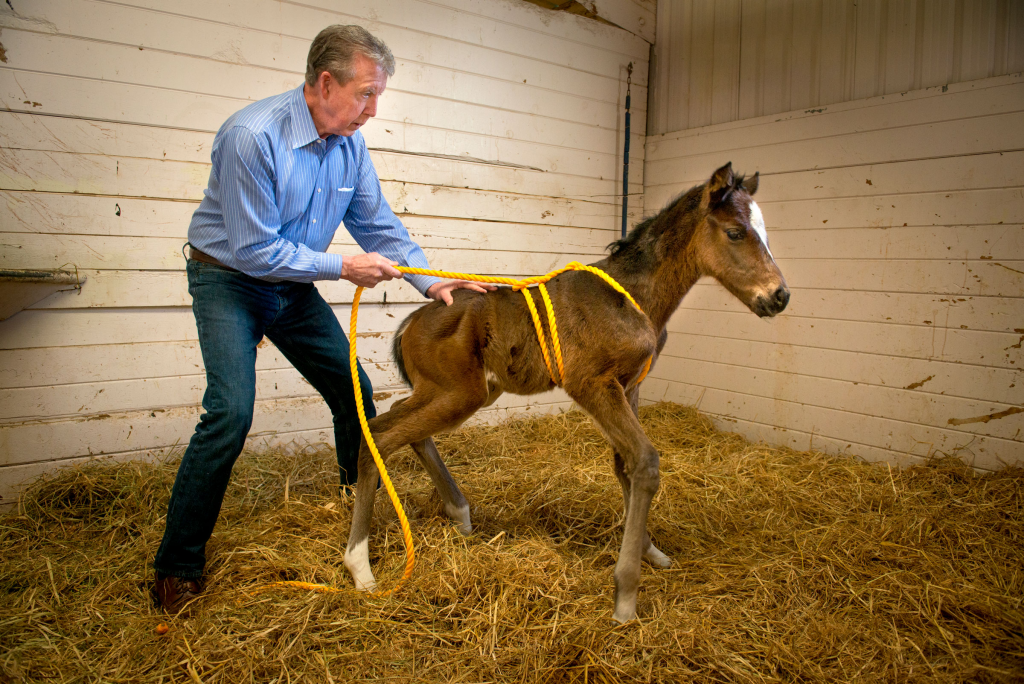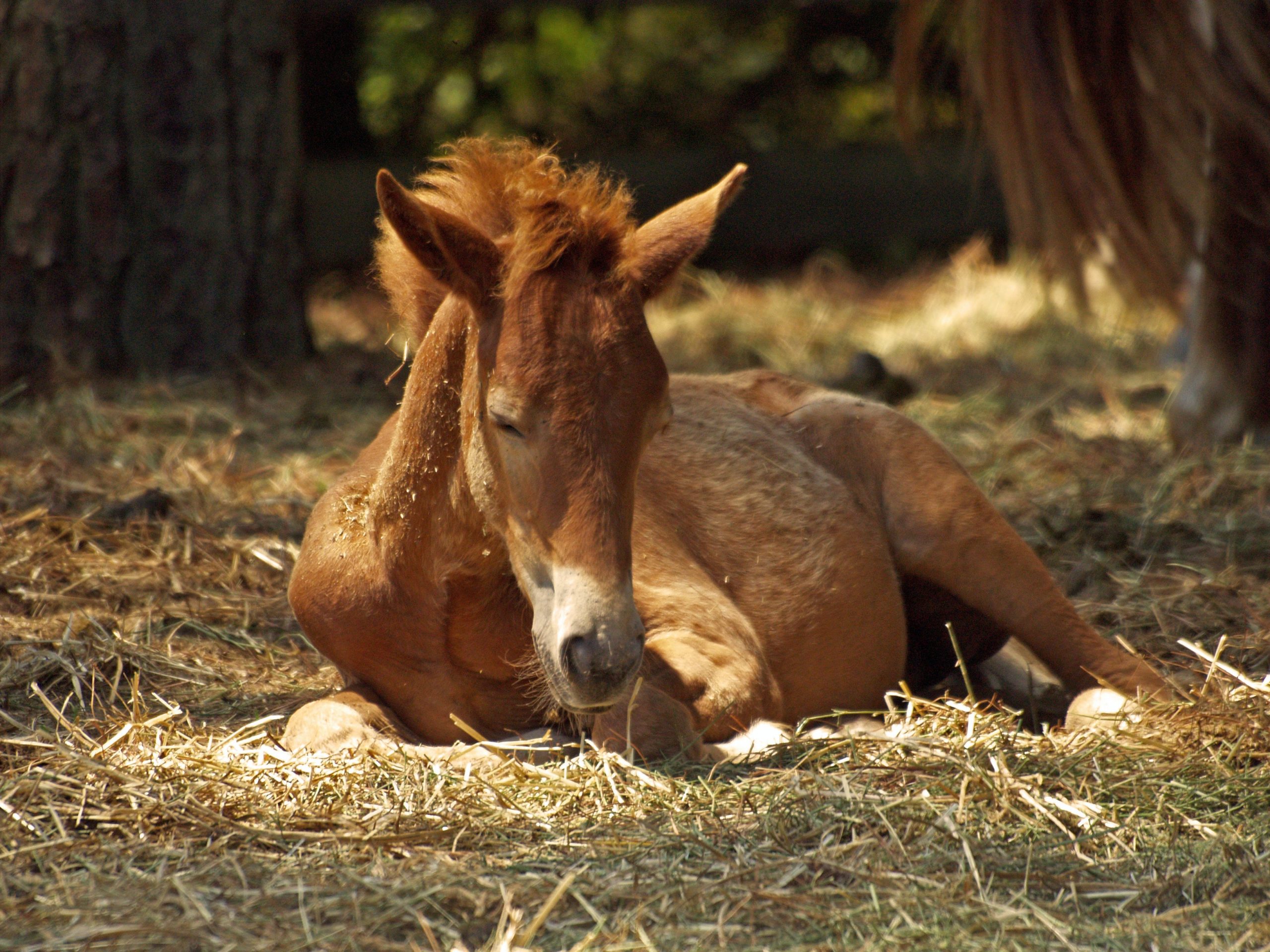Dummy Syndrome
No, we aren’t talking about when you put your coffee in the fridge and forgot lunch on the counter. “Dummy syndrome”, also known as Neonatal Maladjustment Syndrome, Neonatal Encephalopathy or Neonatal Hypoxic Ischemic Encephalopathy can affect humans and animals, seems to have multiple causes and therefore different outcomes and treatments.
It is a term probable best known in the equine community, but “Dummy Syndrome”, aka neonatal maladjustment syndrome, aka neonatal encephalopathy or neonatal hypoxic ischemic encephalopathy, has been identified in many species. The pathophysiology of the condition is not yet perfectly understood but there is good evidence that this clinical presentation (i.e., “syndrome) may have different causes and therefore different treatments and prognoses.
Clinical Signs
When “dummy syndrome” syndrome is suspected, the foal (or calf, cria, lamb, etc.) is born seemingly weak, or floppy. There is little to no suckle reflex, no awareness as to where the udder is, and no effort to bond with the dam. These signs may occur immediately after birth, or, more alarmingly, the babies are born normal but regress within the first day to a disoriented, confused, or despondent stage.
In the most severe cases, the foal may become recumbent and almost comatose, unresponsive to the environment or stimulation. These cases can have difficulties with thermoregulation – shivering despite warm barns and blankets, abnormal breathing patterns – panting and breath holding, decreased gut motility – meconium or fecal impactions, and even metabolic derangements seen as hypo- or hyperglycemia.
Distinguishing the Conditions
Although a conclusive difference between conditions that present this way has not been reported, it is recognized that some neonates will recover, whereas others have a more significant underlying disease leading to this Neonatal Maladjustment Syndrome, or dummy behaviour.
The best-case scenario, based on response to therapy, is what we consider the “simple” Neonatal Maladjustment Syndrome. This is when an outwardly healthy foal (or calf, cria, lamb, kid, etc.) regresses after being born healthy and strong. These cases will begin to dissociate from their dam, will “forget” how to find the udder or teat, and fall asleep on their feet. These babies are still strong and put up a fight when handled, squirming and jumping up when restrained even if the movements are uncoordinated.
The “Madigan” Squeeze
Dr. John Madigan observed experienced foal handlers holding foals a certain way that would make them dopey and “sleep” by putting cranial-caudal pressure on the foal with one arm around the chest, and one behind the rump. When squeezed, these foals will slump to the ground and “sleep” for up to 20 min, as long as the pressure was maintained, and stimulus was minimal. This “sleep” could also be induced when handlers applied ropes to a foal to “cast” them, i.e., lay them down. This worked in foals up to 1 week of age. His observations also noted that when handling certain dummy foals this way, their condition suddenly improved after waking up. From there, he developed, or rather applied, the rope-assisted cast to foals, and demonstrated that it was able to “wake” these dummy foals up and named it the “Madigan Squeeze”.

And yes, the Madigan Squeeze has been applied to other dummy neonates as well with equally impressive results! Calves are probably the second most common species to experience dummy syndrome, with those being born of embryo transfers or via Caesarian section benefiting the most from a Madigan Squeeze, in our experience.

But the Madigan Squeeze does not resolve every issue (12-14% of squeeze foals did not respond). Further research into why the squeeze works on some but not others, identified that some maladjusted foals had high levels of certain neurosteroid hormones that reverted them into an in-utero state. The theory is that this squeeze provides an artificial birth canal pressure, which is the impetus for the hormones to dissipate.

When neonates, foals or otherwise, do not respond to the squeeze, there is a good indication that there is more to their condition. Although the neurosteroid hormones may still be abnormally elevated, a systemic condition may be prompting this “safety mechanism” instead. One such condition may be sepsis, or SIRS (systemic inflammatory response syndrome), which may be associated with Neonatal [Hypoxic Ischemic] Encephalopathy (NIE). In humans, when the neonatal brain is hypoxic, the child may develop Cerebral Palsy among other sequelae. This does not appear to be the case in animals, but life-threatening impairment, damage to the intestine, lungs, organs, heart, and slower response to therapy is observed. Other evidence of ischemic injury or sepsis is sequelae, secondary diseases or injuries, that appear 1-3 week after the initial episodes. Diarrhea, pneumonia, unexpected tachycardia, and tendinitis, are all examples of conditions that may be associated with hypoxic injury in neonates.
Whereas a maladjusted neonate may respond within 1-3 days with basic nursing care, one with NIE may take weeks to fully respond or may never recover despite intensive hospitalized care.
Prevention
Unfortunately, dummy syndrome is not yet fully understood and although the pressure from the birth canal is suspected to be a key feature, this condition does not only affect animals born via C-section. Rather than prevention, vigilance and recognition that large or small birth size, prolonged stage 3 labor, C-section, and systemic illness can increase the chance of dummy syndrome can mean earlier intervention and increased chance of survival.
There are several guides and videos on how to learn and perform the Madigan Squeeze online, so a long, soft rope should definitely be added to all foaling kits. If dummy syndrome worsens or does not respond to a squeeze, veterinary hospitalization is the next best action to ensure round-the-clock nursing and feeding, as well as medical interventions if needed.
Treatment
As mentioned above, the Madigan Squeeze, a rope-casting technique was popularized in foals but can also be used in other livestock species, including calves, crias, and lambs or kids, with variable success. Although research as to the causes of dummy syndrome in other species is lacking, anecdotal reports from veterinarians and producers have indicated favorable response when no other evidence of illness is found.
While some neonates respond immediately or within a few hours after a squeeze, other can take a few days and repeated squeezing before they respond. Therefore, as soon as a dummy is suspected, increased nursing care, bottle or tube-feeding regularly, a warm and clean environment, and veterinary supervision are recommended. Veterinarians will perform an examination and routine blood analysis to assess if there are signs of secondary systemic illness or risks such as failure of transfer of passive immunity (FTPI; previously known as “failure of passive transfer”, or FPT). Intravenous fluid therapy may be provided initially if the neonate is a bit dehydrated from not nursing, and similarly intravenous plasma may also be provided to supplement the immunoglobulins and proteins that may be missing if colostrum intake is insufficient. Antibiotics or medications are typically not required, and therefore should not be used unless there are indications that the neonate is at risk or suffering from sepsis or SIRS.
If you feel that your foal or calf is struggling and are not sure if they are suffering from “dummy” syndrome or something more severe, please contact your veterinarian or our specialists to learn more.
References
1)Toth, B., Aleman, M., Brosnan, R.J., Dickinson, P.J., Conley, A.J., Stanley, S.D., Nogradi, N., Williams, C.D., Madigan, J.E. 2012. Evaluation of squeeze-induced somnolence in neonatal foals. American Journal of Veterinary Research 73 (12), 1881-1889.
2) Flora, T., Smallman, M., Kutzler, M.A. 2021. Resuscitation Compression for Newborn Sheep. Veterinary Clinics of North America: Food Animal 37: 175-181. doi: 10.1016/j.cvfa.2020.10.006.
3) Stillwell, G., Mellor, D.J., Holdsworth, S.E. 2020. Potential benefit of a thoracic squeeze technique in two newborn calves delivered by caesarean section. New Zealand Veterinary Journal 68:1, 65-68. doi: 10.1080/00480169.2019.1670115.
4) “A Cure for the Dummy Cria Syndrome: The Squeeze Maneuver” (2016)
5) Aleman, M., Pickles, K.J., Conley, A.J., Stanley, S., Haggett, E., Toth, B., Madigan, J.E. 2013. Abnormal plasma neuroactive progestagen derivatives in ill, neonatal foals presented to the neonatal intensive care unit. Equine Veterinary Journal 45, 3-3.
6) Aleman, M., Weich, K.M., Madigan, J.E. 2017. Survey of veterinarians using a novel physical compression squeeze procedure in the management of neonatal maladjustment syndrome in foals. Animals 7 (9), 69.
7)Pickles, K.J., Madigan, J.E., Torske, S., Aleman, M.R. 2014. Use of Squeeze‐Induced Somnolence for Routine Plasma Administration in Healthy Neonatal Foals. Equine Veterinary Journal 46, 4-4

